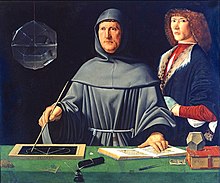Pacioli
| Luca Bartolomeo de Pacioli | |
|---|---|

Portrait of Luca Pacioli, traditionally attributed to Jacopo de' Barbari, 1495 (attribution controversial).
|
|
| Born |
c. 1447 Sansepolcro, Republic of Florence |
| Died | 1517 (aged 70) Sansepolcro, Republic of Florence |
| Citizenship | Florentine |
| Occupation | Friar, mathematician, writer |
| Known for |
Summa de arithmetica, De divina proportione, double-entry bookkeeping |
Fra Luca Bartolomeo de Pacioli (sometimes Paccioli or Paciolo; c. 1447–1517) was an Italian mathematician, Franciscan friar, collaborator with Leonardo da Vinci, and a seminal contributor to the field now known as accounting. He is referred to as "The Father of Accounting and Bookkeeping" in Europe and he was the first person to publish a work on the double-entry system of book-keeping on the continent. He was also called Luca di Borgo after his birthplace, Borgo Sansepolcro, Tuscany.
Luca Pacioli was born between 1446 and 1448 in the Tuscan town of Sansepolcro where he received an abbaco education. This was education in the vernacular (i.e., the local tongue) rather than Latin and focused on the knowledge required of merchants. His father was Bartolomeo Pacioli; however, Luca Pacioli was said to have lived with the Befolci family as a child in his birth town Sansepolcro. He moved to Venice around 1464, where he continued his own education while working as a tutor to the three sons of a merchant. It was during this period that he wrote his first book, a treatise on arithmetic for the boys he was tutoring. Between 1472 and 1475, he became a Franciscan friar. Thus, Luca Pacioli could be referred to simply as Friar Luca.
In 1475, he started teaching in Perugia, first as a private teacher, from 1477 holding the first chair in mathematics. He wrote a comprehensive textbook in the vernacular for his students. He continued to work as a private tutor of mathematics and was instructed to stop teaching at this level in Sansepolcro in 1491. In 1494, his first book, Summa de arithmetica, geometria, Proportioni et proportionalita, was published in Venice. In 1497, he accepted an invitation from Duke Ludovico Sforza to work in Milan. There he met, taught mathematics to, collaborated, and lived with Leonardo da Vinci. In 1499, Pacioli and Leonardo were forced to flee Milan when Louis XII of France seized the city and drove out their patron. Their paths appear to have finally separated around 1506. Pacioli died at about the age of 70 in 1517, most likely in Sansepolcro where it is thought that he had spent much of his final years.
...
Wikipedia
